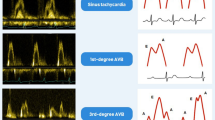Abstract
The three EBMs in the title refer to the following concepts: evidence-based medicine, experience-based medicine, and echo-based medicine. Evidence-based medicine: I have carried out the following clinical research using transthoracic Doppler echocardiography: (1) noninvasive pulsed-wave Doppler echocardiographic detection of the direction of shunt flow in patients with atrial septal defect: usefulness of the right parasternal approach (1985), (2) significance of laminar systolic regurgitant flow in patients with tricuspid regurgitation: a combined pulsed-wave, continuous-wave, and two-dimensional echocardiography (1990), (3) obstruction of the inferior vena caval orifice by the giant left atrium in patients with mitral stenosis: a Doppler echocardiographic study from the right parasternal approach (1992), and (4) demonstration of a localized acceleration flow signal in the transmural penetrating coronary artery using transthoracic color and pulsed-wave Doppler echocardiography in patients with hypertrophic cardiomyopathy (1996–2017). Experience-based medicine: Dr. Eugene Braunwald says “The best book of cardiology is the patient itself.” I have conducted my modest research activities gleaning hints through day-to-day routine work and sometimes investigating experimentally using the Doppler echocardiographic method. I have also learned from the Japanese Society of Echocardiography that a physician should stand between evidence-based medicine and experience-based medicine. Echo-based medicine: This term is intended to express my personal determination. I believe that echocardiography is the stethoscope of the 21st century. It is a safe, painless, low-cost, and repeatable tool at the bedside. I expect that echocardiography can reduce unnecessary healthcare costs and appropriately select reasonable examinations for patients. I would like to devote the time left in my career to the study of cardiovascular medicine, believing in the power of echocardiography and the Doppler method to provide a link between evidence-based medicine and experience-based medicine.













Similar content being viewed by others
References
Shub C, Dimopoulos IN, Seward JB, et al. Sensitivity of two-dimensional echocardiography in the direct visualization of atrial septal defect utilizing the subcostal approach: experience with 154 patients. J Am Coll Cardiol. 1983;2:127–35.
Weyman AE, Wann LS, Caldwell RL, et al. Negative contrast echocardiography: a new method for detecting left-to-right shunts. Circulation. 1979;59:498–505.
Tei C, Tanaka H, Kashima T, et al. Real-time cross-sectional echocardiographic evaluation of the interatrial septum by right atrium-interatrial septum- left atrium direction of ultrasound beam. Circulation. 1979;60:539–46.
Tei C, Tanaka H, Nakao S, et al. Motion of the interatrial septum in acute mitral regurgitation. Clinical and experimental echocardiographic studies. Circulation. 1980;62:1080–8.
Levin AR, Spach MS, Boineau JP, et al. Atrial pressure-flow dynamics in atrial septal defects (secundum type). Circulation. 1968;37:476–88.
Alexander JA, Reinbert JC, Sealy WC, et al. Shunt dynamics in experimental atrial septal defects. J Appl Physiol. 1975;39:281–6.
Minagoe S, Tei C, Kisanuki A, et al. Noninvasive pulse Doppler echocardiographic detection of the direction of shunt flow in patients with atrial septal defect: usefulness of the right parasternal approach. Circulation. 1985;71:745–53.
Hatle L, Angelsen B. Doppler ultrasound in cardiology. Philadelphia: Lea & Febige; 1982.
Miyatake K, Okamoto M, Kinoshita N, et al. Evaluation of tricuspid regurgitation by pulsed Doppler echocardiography. Circulation. 1982;66:777–84.
Minagoe S, Chandraratna PAN, Rahimtoola SHB. Significance of laminar systolic regurgitant flow in patients with tricuspid regurgitation: a combine pulse-wave, continuous-wave and two dimensional echocardiography. Am Heart J. 1990;119:627–35.
Kitabatake A, Inoue M, Tanouchi J, et al. Transmitral blood flow reflecting diastolic behavior of the left ventricle in health and disease: a study by pulsed Doppler technique. Jpn Circ J. 1982;46:92–102.
Minagoe S, McKay CR, Chandraratna PAN. Doppler echocardiographic left ventricular filling dynamics in patients with right ventricular overload (abstr). Circulation. 1985;72:III–352 (58th Scientific Sessions held November 11–14, 1985, in Washington D.C.).
Louie EK, Rich S, Brundage BH. Doppler echocardiographic assessment of impaired left ventricular filling in patient with right ventricular pressure overload due to primary pulmonary hypertension. J Am Coll Cardiol. 1986;8:1298–306.
Minagoe S, Yoshikawa J, Yoshida K, et al. Obstruction of the inferior vena caval orifice by the giant left atrium in patients with mitral stenosis: a Doppler echocardiographic study from the right parasternal approach. Circulation. 1992;86:214–25.
Minagoe S, Toyama Y, Yamaguchi H, et al. Transthoracic Doppler echocardiographic detection of intramyocardial coronary artery flow in humans using high frequency transducer. J Cardiol. 1997;30:149–55.
Kim WS, Minagoe S, Mizukami N, et al. No reflow-like pattern in intramyocardial coronary artery suggests myocardial ischemia in patients with hypertrophic cardiomyopathy. J Cardiol. 2008;52:7–16.
Canty JM, Dunker DJ. Coronary blood flow and myocardial ischemia. Braunwald’s heart disease: a textbook of cardiovascular medicine. 10th ed. Philadelphia: Saunders; 2015. p. 1039.
Camici PG, Crea F. Coronary microvascular dysfunction. N Engl J Med. 2007;356:830–40.
Crea F, Lanza GA, Camici PG. Comparative summary of the available methods to investigate coronary microvascular function. Coronary microvascular dysfunction. Milan: Springer; 2014.
Maron BJ, Wolfson JK, Epstein SE, et al. Intramural (“small vessels”) coronary artery disease in hypertrophic cardiomyopathy. J Am Coll Cardiol. 1986;8:545–57.
Tanaka M, Fujiwara H, Onodera T, et al. Quantitative analysis of narrowing of intramyocardial small arteries in normal hearts, hypertensive hearts, and hearts with hypertrophic cardiomyopathy. Circulation. 1987;75:1130–9.
Jaski BE. The 4 stages of heart failure. Minnesota: Cardiotext; 2015. p. 42.
Meet the history: Application of the ultrasound Doppler method to cardiac examination. Shinzo 2010;42:1500–12.
Author information
Authors and Affiliations
Corresponding author
Ethics declarations
Conflict of interest
Shinichi Minagoe declares that he has no conflicts of interest.
Rights and permissions
About this article
Cite this article
Minagoe, S. Nimura lecture: “Three EBMs”. J Echocardiogr 16, 6–19 (2018). https://doi.org/10.1007/s12574-017-0369-x
Received:
Accepted:
Published:
Issue Date:
DOI: https://doi.org/10.1007/s12574-017-0369-x




